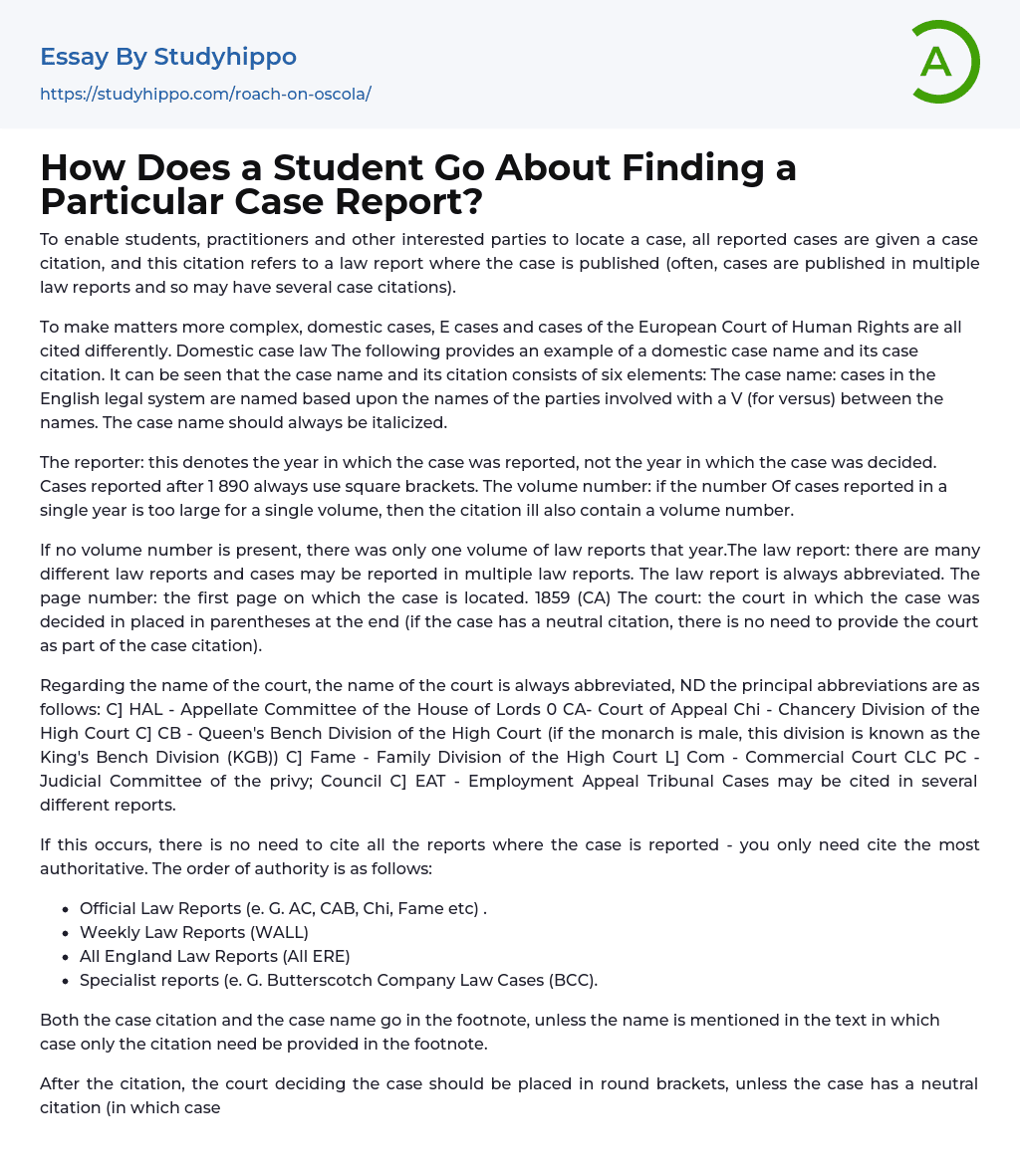

How Does a Student Go About Finding a Particular Case Report? Essay Example
To enable students, practitioners and other interested parties to locate a case, all reported cases are given a case citation, and this citation refers to a law report where the case is published (often, cases are published in multiple law reports and so may have several case citations).
To make matters more complex, domestic cases, E cases and cases of the European Court of Human Rights are all cited differently. Domestic case law The following provides an example of a domestic case name and its case citation. It can be seen that the case name and its citation consists of six elements: The case name: cases in the English legal system are named based upon the names of the parties involved with a V (for versus) between the names. The case name should always be
...italicized.
The reporter: this denotes the year in which the case was reported, not the year in which the case was decided. Cases reported after 1 890 always use square brackets. The volume number: if the number Of cases reported in a single year is too large for a single volume, then the citation ill also contain a volume number.
If no volume number is present, there was only one volume of law reports that year.The law report: there are many different law reports and cases may be reported in multiple law reports. The law report is always abbreviated. The page number: the first page on which the case is located. 1859 (CA) The court: the court in which the case was decided in placed in parentheses at the end (if the case has a neutral citation, there is no nee
to provide the court as part of the case citation).
Regarding the name of the court, the name of the court is always abbreviated, ND the principal abbreviations are as follows: C] HAL - Appellate Committee of the House of Lords 0 CA- Court of Appeal Chi - Chancery Division of the High Court C] CB - Queen's Bench Division of the High Court (if the monarch is male, this division is known as the King's Bench Division (KGB)) C] Fame - Family Division of the High Court L] Com - Commercial Court CLC PC - Judicial Committee of the privy; Council C] EAT - Employment Appeal Tribunal Cases may be cited in several different reports.
If this occurs, there is no need to cite all the reports where the case is reported - you only need cite the most authoritative. The order of authority is as follows:
- Official Law Reports (e. G. AC, CAB, Chi, Fame etc) .
- Weekly Law Reports (WALL)
- All England Law Reports (All ERE)
- Specialist reports (e. G. Butterscotch Company Law Cases (BCC).
Both the case citation and the case name go in the footnote, unless the name is mentioned in the text in which case only the citation need be provided in the footnote.
After the citation, the court deciding the case should be placed in round brackets, unless the case has a neutral citation (in which case the neutral citation will indicate the court), or unless the case was decided before 1865. The following provides examples of cases mentioned in the text and cases not mentioned in the text. Example - Citing case law The House of Lords has
acknowledged that the courts may have regard to Hangars when interpreting legislation. The case of Pepper v Hart established that the courts may have regard to Hangars when interpreting legislation. .
Using the above example, if you quoted from Pepper v Hart and the quote was from page 602, the footnote would cite the source thus. 4 If you name the judge in the text, there is no need to repeat it in the footnote. If you do not name the judge in the text, you should state the judge's name in the footnote in parentheses following the page number of the quote.
Note 'pet is no longer used. The following examples demonstrate this: Example - Quoting from a judgment In Royal College of Nursing v DADS,I Lord Diploid described the drafting of s 1(1) of the Abortion Act 1967 as being 'far from elegant. Since 2001, many cases, in addition to having a case citation, will also have what is called a neutral citation.
The case of R v Morrison that we discussed above, in addition to having a case citation, also has a neutral citation, which consists of three elements. The case name The judgment year: the year of the judgment is given in square brackets. This differs to the case citation, which provides the year the case was reported (although the two are often the same).
- Federal government essays
- Armed Forces essays
- Confederate States Of America essays
- Federal Government Of The United States essays
- Fourteenth Amendment To The United States Constitution essays
- Governance essays
- Parliament essays
- Politics essays
- Jurisdiction essays
- Bureaucracy essays
- Separation Of Powers essays
- Congress essays
- President essays
- United States Congress essays
- Non-Commissioned Officer essays
- Appeal essays
- Revenge essays
- Corporate Governance essays
- Public Service essays
- Income Tax essays
- Supply essays
- Red Cross essays
- Democracy essays
- State essays
- Liberty essays
- Absolutism essays
- Reform essays
- Republic essays
- John Marshall essays
- Bourgeoisie essays
- Developed Country essays
- Elections essays
- International Relations essays
- Left-Wing Politics essays
- Monarchy essays
- Political Corruption essays
- Political Party essays
- Political Science essays
- Sovereign State essays
- United Nations essays
- World Trade Organization essays
- Contras essays
- Dictatorship essays
- Foreign policy essays
- Monarch essays
- Corruption essays
- Foreign essays
- Democratic Party essays
- European Union essays
- President Of The United States essays



